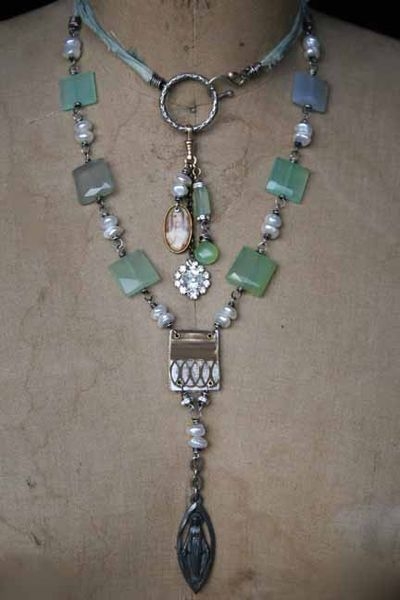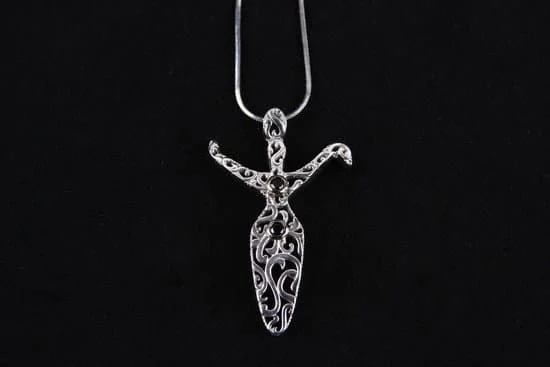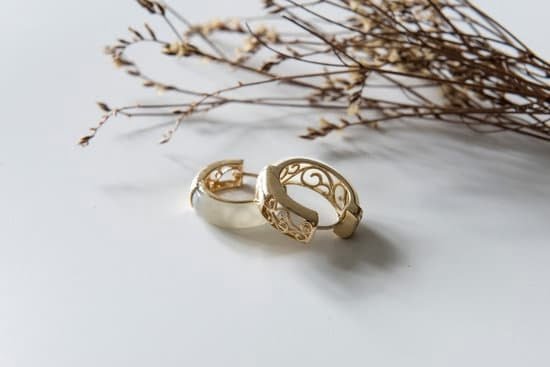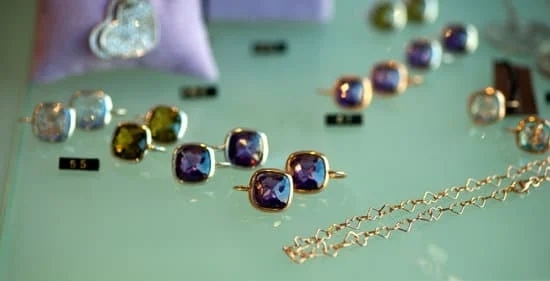Victorian era hair jewelry is defined as adornments that are crafted using a deceased loved one’s locks of hair and jewels. During the Victorian era in England, it was quite common to create special pieces of jewelry with the deceased’s locks of hair to memorialize them in an aesthetically pleasing way. These unique souvenirs were particularly popular among middle-class families who didn’t have access to expensive materials like gold or diamonds to craft jewelry with.
Design – Techniques and materials used for crafting hair jewelry
Hair jewelry created during the Victorian era was often made from a range of different materials such as metals, pearls, semi-precious stones, glass beads, waxed threads, and ribbons. Utilizing various techniques such as plaiting, knotting, looping, crochet hooks and/or hand tools such as needle nose pliers and cutters craftsmen were able to construct elaborate and intricate pieces of jewelry.
Typically each piece would include silver resulting in a matte finish but upon request could be fashioned gold or copper creating a more lustrous appearance.
Popular Styles – Samples of the most sought after pieces during this period
One of the most popular Victorian Era Hair Jewelry designs were brooches crafted in three dimensional themes or figures such as roses or stars. Chains with matching pendants featuring photos often encased in silver or gold frames surrounded by amber colored stones also gained wide popularity among collectors due to its ornate design features which included both smooth edges and intricate carved textures.
In addition necklaces styled in an open circle forming a wreath intertwined with rosebuds wrapped around centred images were highly favoured during this period for their symbolic representation of life cycles never ending nature.
Origin
Hair jewelry has been around since Ancient Greece and Ancient Egypt, but it was during the Victorian Era when it became popular and grew in popularity. In this era, individuals proudly showcased their carefully crafted pieces of jewelry, which served as an outward display of inner feelings and sentiments.
During this time period, properly storing strands of hair that belonged to a loved one or a special occasion was a popular custom among the wealthy. This type of jewelry would include lockets or pendants for necklaces crafted from gold, silver or brass containing intricate designs with a loved one’s hair intertwined throughout the design.
The use of human hair as jewelry quickly expanded beyond mourning rings and lockets during the mid-nineteenth century due to advances in tooling technology, which made it possible to achieve intricate detail with relative ease. As tools improved so did the craftsmanship; many craftsman focused on creating elaborate jewelry pieces made out of shellac and small bits of human hair with images that ranged from romantic love scenes to portraits, floral motifs and large stately homes like Blenheim Palace.
This craft relied almost entirely on precision and skill passed down through generations.
Increasingly ornate Victorians hair pieces included other items such as photos, dried flowers or locks of fur from pets. These objects were used to capture memories both joyous and bittersweet; these were captured on two-dimensional surfaces, in 3D bundles known as ‘hair work’ pieces where multiple strands were woven together in elaborate patterns or knotted into intricate loops similar those seen in macramé today.
These pieces could range from delicate woven bracelets featuring tiny curls fashioned with bright beads to combs decorated in floral motifs with baby’s first curl sewn into them.
Hair art remains coveted by collectors who understand its beauty and sentimental value. With advancements made over time not only has hairstyling techniques advanced but so have techniques on how to properly preserve hair giving rise to demand again once more for keepsakes made entirely fantastic by Victorians imagination increasing the popularity even further from its antiquity period still standing put until today.
Types of Jewelry
The Victorians had a love affair with hair jewelry, and it was quite common for women in the Victorian era to adorn their hair. Hair jewelry ranged from ornate pieces of jewelry to ornate tiaras, combs, and pins. One type of ornamentation commonly used in hairjewelry in the Victorian era was freshwater pearls.
Freshwater pearls were used to create intricate designs that would be pinned within an updo hairstyle or arranged into garlands or locks of hair. They provided an air of sophistication, elegance and grace and often featured diamonds or other semi-precious stones.
Headpieces were also a popular choice when it came to styling one’s hair during this period, often taking the form of intricately adorned tiaras or woven headbands made from leather, velvet and silk ribbon. These headpieces could be decorated with precious stones such as diamonds, emeralds, rubies or sapphires as well as colorful feathers and fabric flowers.
This type of decoration served both aesthetic and symbolic purposes; many serving as symbols representing marriage or rank within society while at the same time highlighting the wearers impeccable style sense.
In addition to headpieces such as tiaras and crowns, women also wore elaborate hair accessories including pins brooches barrettes side combs and snoods which frequently contained opalescent gems like jasper agates or malacite. Furthermore due to its use for buns top knots chignons plaits wraps bows loops fishtails turban styles European models etc a plethora of combs pins tassels buckles flowers ribbons etc could all be used for decorative accents often achieving dramatic effects when interspersed throughout ones hairdo.
Whether designed to convey status or attract attention Victorian Era Hair Jewelry paved ways for various ways we still adorn our hairstyles today creating individualized looks with impactful statements.
Adornment
The Victorian era is well remembered for its expansive and ornamental details, and hair jewelry was an intricate part of this era. Hair jewelry served as a way to showcase a woman’s beauty while simultaneously expressing her personality.
Using the hair of either themselves or their deceased loved ones, women would craft various pieces with locks of hair that could be worn personally or given away as gifts and kept as momentos. Hair jewelry was immensely popular during this era due to their sentimental value and symbolic representation of love, notably in the form of bracelets, broaches, wreaths, pins, rings, lockets and earrings made from intertwined braids.
Hairwork pieces were often fashioned into intricate designs that showcased precision craftsmanship through complex loops and delicate weaving. This form of art utilized shells and pearls to further foster the beauty present in each piece.
During this time period, it was incredibly common for special occasion gifts to consist of a token piece of hair jewelry such as locket with strands tied inside or another piece adorned with lace detailing or precious stones. Oftentimes the gift exchanged held personal significance; in regards to both the intended recipient’s identity individuals within a romance that gifted one another tokens from one another’s head or body parts were also commonplace during this period.
Victorian ladies also embraced elaborate hairstyles combined with specially crafted tiaras adorned with gold filigree details meant to signify one’s faithfulness to her spouse complimented by fringed shawls. Each detail carefully reflected specific motifs related to matrimonial festivities that captured distinct societal expectations surrounding marriage at the time including longterm beliefs regarding fidelity among other attributes.
These artifacts remain prominent within many cultures today as they continue to serve purpose much like those in recent past with occasional modernized materials used for durability over vintage charm when necessary.
Popularity
The Victorian Era not only ushered in an era of advances in technology and science, but also spawned a new style of jewelry: the hair memento. Hair jewelry was popular during this time because it allowed people to express their feelings and commemorate an important group or individual.
During this period, access to jewelry encouraged people to embrace the concept of hair mementos as a way to mark milestones or remember loved ones. Additionally, improved access to tools like scissors and needle threaders made it easier for people to create intricate pieces of jewelry that were unique.
In addition to convenience of production, several factors may have contributed to the growing popularity of hair trinkets during the Victorian Era. For example, Christianity played an important role in the lives of many Victorians and religiosity corresponded with a greater adoption rate of hair keepsakes. By weaving sentimental value into these pieces, many viewed them as a sign of faith or connection with God.
The social standing of Victorians likely gave them another reason for creating these ornate baubles: it demonstrated both class and identity. Typically, higher classes were able to afford more expensive materials like gold, tortoise shell, gems which could be used as decorations. As a result, creating Victorian-era jewelry from human hair was often seen as proof that you belonged to a certain social rank and indicated status or privilege within that sector.
Finally, collecting human-hair keepsakes were part of having romantic relationships in the Victorian Era; lovers’ locks started with two locks collected on either side being sent back and forth between couples until they married each other or broke up. Fashion accessories were worn by both parties as reminders of love before exchanging vows officially – married women had pins or bracelets with their own hair while men carried lockets containing their lovers’ tresses throughout courtship.
This tradition helped reinforce the popular sentiment that material objects can hold profound emotional significance beyond their financial worth.
Techniques
One of the most popular techniques used to create hair jewelry during the Victorian era was braiding. This was a versatile method that allowed the creator to choose a variety of materials including ribbon, lace, and even fabric scraps to incorporate into the braids.
An intricate interweaving process involving two, three or more strands could be employed in order to create different effects such as fringe and rosettes. More elaborate arrangements like flowers and butterflies could also be created using this technique – so intricate and beautiful were some of these hairstyles, they were referred to as ‘Art Nouveau hair jewels’ in England.
Plaiting was another technique used in Victorian era hair jewelry. This process involved tying several pieces of material together and then forming them into an intricate pattern by twisting them around each other. Colors and design elements can blended together to create interesting combinations – which sometimes utilized glass beads or chains for added embellishment. Braids ornaments created through this particular method were often paired with structured parasols for a look of sophistication.
Finally, weaving was also a popular technique for creating stunning adornments during the Victorian era. It typically consisted of interlocking ribbons or strings into an open pattern-like structure, resulting in details such as knots, bows and tassels that would fasten over the top portion of a woman’s hair up do. The use of feathers in weaves added exotic flair while shells & fine threadwork gave even more texture and detail to these pieces of hair artistry.
Accessibility
The Victorian Era, spanning mid – 1837 to 1901, was a period of great change for society. One area that reflected this was in the increased availability of hair jewelry.
The nature of the craftsmanship varied depending on an individual’s social class; While those in high society had access to expensive and finely crafted pieces sourced from specialty shops and goldsmiths, the everyday person typically created their own pieces from whatever materials they could acquire or repurpose. This meant that anyone could easily create jewelry out of ribbon, threads, ribbons, feathers and other ‘found’ items.
As a result, it was not uncommon to see elaborate showpieces at special events such as dances and balls; women would adorn themselves with intricate hairstyles decorated with pearls, beads, gems and metallic filigree. Additionally, hair jewelry found its place in many religious ceremonies such as weddings where the bride customarily wore her mother’s wedding jewellery symbolizing their spiritual bond. Meanwhile men wore more subdued styles in keeping with their image as traditional British gentlemen.
Conclusions
The Victorian era ushered in a time of innovation and creativity, which is exemplified in the unique pieces of hair jewelry that were crafted during this period. The sheer range and diversity of styles made alluring by their intricate craftsmanship, use of precious stones, and clever design set hair jewelry apart from other fashionable accessories. There is something undeniably special about these pieces and it is no wonder they continue to tantalize viewers to this day.
Hair jewelry from the Victorian era often holds much more than aesthetic value–it can also tell stories and serve as tangible connections to one’s past. For example, mourning pendants were an important part of many people’s lives during this period because it provided them with a means to express grief when loved ones passed away.
Its incorporation of braided or intertwined strands of hair held psychic energy that gave it immense personal significance and was often worn with great pride and devotion.
What we can learn from the aesthetic choices made during the Victorian era is fascinating. These objects demonstrate a strong preference for intricate detail, symmetry, colors from nature, and subtle motifs that reflect a sophistication that remains desirable even 150 years later. Therefore, it can be said hair jewelry from this century serves both as poignant reminders of our history as well as exquisite decorations that offer modern audiences yet another chance to appreciate the beauty intended for earlier generations.

Welcome to my jewelry blog! My name is Sarah and I am the owner of this blog.
I love making jewelry and sharing my creations with others.
So whether you’re someone who loves wearing jewelry yourself or simply enjoys learning about it, be sure to check out my blog for insightful posts on everything related to this exciting topic!





